Artificial Intelligence (AI) has seen an unprecedented interest and growth, both in terms of academic research and rapid industry adoption. As per numerous academic researchers and industry leaders, in 2020, no one had imagined the progress and development that this field has experienced. They are still in awe at how this technology, still in its nascence, is aiding with ground-breaking abilities to perform critical tasks which until recently were considered not feasible! However, most people in general still corroborate AI to ‘Terminator Movies’ of the yesteryears. This is further relevant in the healthcare industry where ‘healthcare data of any patient or product’ is extremely sensitive and thereby exceptionally challenging to acquire. This human perception needs to change and it is only possible through education, explainability and fabrication of fundamental principles, that shall guide in AI Adoption by Industry in a safe, secure and regulated fashion, reducing the risk of conflict and fatalities. The authors’ of this article deliberate on the progress, maturity, applications, challenges of AI and thereby positions a construct of such fundamental principles, derived through extensive research, industry experience, excerpts from industry leaders and journal literature survey.
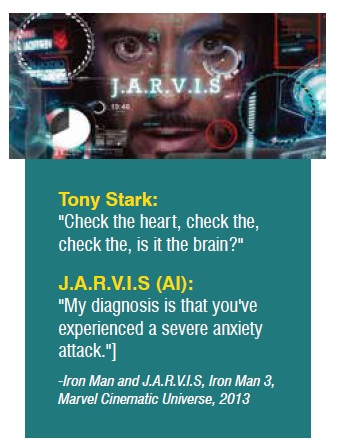
While Amazon’s Alexa and Google’s Home internet of things (IoTs) are the most popular IoT devices available widely in the market, they are still impaired in their ability to perform advanced activities described in the above quote from a popular movie franchise. Concurrently, the industry is severely stinted in being able to a) formalise data requirement, b) etup databases, c) tackle inherent bias, d) setup security measures, e) manage patient safety issues that may arise and f) introduce timely regulatory legislation to aid in effective governance and thereby adoption of AI.
The world is at the edge of global transformation, heralding the advent of global digitalisation! It is different from the prior era of digital globalisation where few enterprises concocted some maturedand standardised digital platforms to connect people across the world, whereas now in the age of global digitalisation it has become a quintessential necessity to synergise and deploy digital platforms. All this, while the industry and patients grapple with the reality of witnessing the commercial deployment of iteratively learning algorithms, in every facet of life.
It is no different in the field of healthcare. Until very recently, there existed an acute lack of standardisationsand regularisation in software as medical devices (SaMDs) and the internet of medical things (IoMTs). This culminated in earth of interoperable, secure and synchronous ‘capture’ and ‘processing’ of enhanced medical meta data supporting in healthcare manufacturing, healthcare services as well as clinical diagnostics. The same was true for even the United States Food and Drug Administration (FDA), who though proactive since 2014 in attempting the regulatory constructs, were still overdue considering the accelerated development of digital technologies. This deficit was especially felt in aiding adoption, application and incubation of machine learning (ML) and AI in SaMD. Hence, the patient community was often forced to adopt conventional healthcare technologies for survival, despite the incumbent technology advantage.
AI is defined by 2020 editorial in Nature as ‘intelligence demonstrated by machines’. The article discusses and deliberates on a myriad of approaches taken by researchers since the mid 90’s to effectively define AI but concludes with “We can expect that what is generally considered as intelligence and ‘artificial intelligence’ will remain in flux. By integrating advances from different disciplines, there is an opportunity to create intelligent machines with ever greater complexity.” This article will hence not deliberate further on definition but consider ANY machine of any form factor, physical (hardware) or ethereal (software) demonstrating ability to provide deduction using data provided as input or self-assimilation and demonstrating the capability of differential decisions as AI.
Therefore, both supervised (forecast or predict outcomes based on the use of labeled data provided to an algorithm) and unsupervised (predict outcomes based on unlabelled data sets through hidden patter recognition in data) techniques used by ML and deep learning (DL) algorithms, can classified as AI. However, based on recent observations, it is the iterative or self-learning DL algorithms and architectures that will essentially mould the future for AI.
Presently, AI is of the form of artificial narrow intelligence (ANI). These algorithms drive most AI applications across industries but is primarily useful in predicting, classifying or clustering outcomes at a local or singular task level and cannot be expected to generalise the ‘level’ of outcome, across multiple tasks or applications. For example, ANI can be trained and validated to play chess but will NOT be able to apply the same learning as playing chess to playing dominoes, unless specifically trained on the same data. However, the developers of AI algorithms currently strive to provide a level of general intelligence termed currently as Artificial General Intelligence or AGI which aims to rely of current learnings in one task and develop rules that may be applied across multiple intellectual tasks.
The holy grail, as per researchers would be the artificial super intelligence (ASI), which would mimic human ability to perform cognitive tasks. However, that concept is a conjecture at this time.
It is often said that war is the harbinger of innovation. Like the birth of radars, computers and penicillin during the WWII, affliction inflicted by COVID-19 has provided an unprecedented impetus, resulting in paradigm shifts in the traditional way of designing, planning, execution and deployment of healthcare using AI/ML enabled SaMD. The impact has been especially evident in the field of vaccine development when the world united to develop and license ‘emergency use’ of the anti-Covid vaccine, within a year since COVID-19’s inception. And almost like a medical marvel, the vaccine has inherently been successful across the globe, irrespective of the type of populace.
Thus, what typically takes 10-15 years for commercialisation was built within a year. This success would not be remotely possible without the extensive application and adoption of virtual ‘in-silico’ (in simulation) screening using neural networks (Net.) like long short term memory net (LSTM), recurrent neural net (RNN) or convolution neural net (CNN), to name a few popular algorithms.

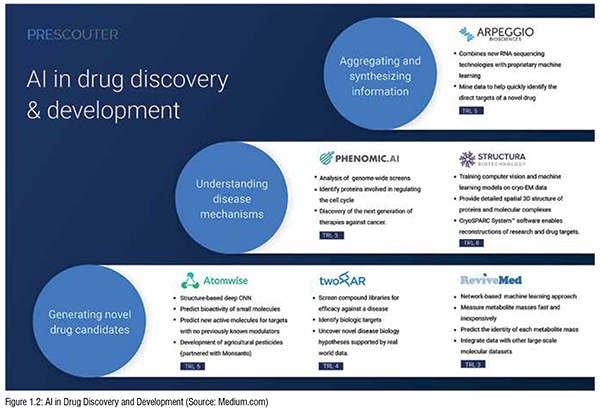
Fast forward to 2022 and the healthcare industry has begun adoption of ANI in their intrinsic operational and tactical workload to alleviate cost and human effort, especially in their business-critical operations. The adoption is idespread and covers a plethora of healthcare industries and their respective functions. The industries can be classified into the following – 1. Healthcare (Devices and Pharma Manufacturing), 2. Pharma Drug Designing and Biotechnology (Gene therapy, in-silico Virtual Screening,Clustered regularly interspaced short palindromic repeats or CRISPR based gene manipulation), 3. Clinical Diagnostics, 4. Hospital Management - Medical and Operational Records Management and Analysis to drive better patient outcomes, 5. Advanced Telemetry based Home Health-Care for effective Rehabilitation, 6. Proactive and Pre-active Care measures to drive preventive patient outcomes.
Figure 1.1 depicts the most prominent use cases for applied ANI in medical device manufacturing where application of Defect Detection (images processing in a CNN algorithm) and Anomaly Detection (based on data provided by sensors in the manufacturing line), have enabled the Medical Device industry to take action on a device or a manufacturing conveyor line to eradicate the presence of defects, thereby improving regulatory control and delivering on faster, safer and better patient outcomes with minimal product recalls. The above use cases are also applicable for the Pharma manufacturing processes as well.
Figure 1.1 depicts the most prominent use cases for applied AI in Drug Discovery, Design and Development where LSTMs and RNNs have been applied to predict inhibitor molecules using the lock and key hypothesis to generate protective drugs or vaccines against pathogenic protein sheath. In parallel, similar algorithms have also been used in variation to identify biomarkers for pathogens, physiological processes and diseases in a faster and cost-effective manner. Understanding the disease mechanisms and biomarkers help in essential root cause analysis of the disease itself, which when synergised with patient clinical trial information and aggregated in a database, helps in allaying multiple challenges.
While these ANI ‘applications’ are immeasurable, researchers and developers revel in the fact that the extrinsic architecture of these algorithms are robust and are mostly perpetual, thereby remaining akin to the base architecture regardless of any specific application. Only the hyperparameters intrinsic to each DL technique (such as weights, biases, learning rate etc.) changes to train and validate an ANI for a specific task.
With regards to recent applications in healthcare manufacturing, an analytics services company was recently chartered by a Fortune 500 healthcare client to design, build and deploy a ‘multi-defect detection’ ANI model for a particular line of medical device, while its still in the manufacturing line. The analytics company was able to successfully deliver on such an ANI, with an ‘F1 score’ (maintains both sensitivity and specificity of task done by a model) governed 95 per cent accuracy. This alleviated the client problems of cyclical variation in quality management process, thereby minimizing product recalls, enabling the client to abolish the yesteryears process of quality management through human intervention and thus bringing in considerable reduction in cost.
In a discussion with Velbiom Probiotics, India’s first and exclusive probiotics company, Saikat Ray, CEO at Velbiom highlighted regarding the dire need of AI/ML derived applications required in their field. “Probiotics is looking at the root causes of how a healthy microbiome can alleviate variegated critical diseased conditions that might afflict patients in their future, thereby is focusing on pre-biotics, i.e., chemicals which enable maintenance of a healthy microbiome in any body, thus a healthy balance of good bacteria in the body”. This aims at revolutionising conventional healthcare by transforming Reactive Care to not only Preventive care but inculcating Pro-active Care as a behaviour / hygiene in the next generation, from an early age. Currently, data in this field which is at its nascence is scarce and Saikat believes that AI is set to play a key role in identifying the all the different types and proportion of good bacteria, comprising a healthy microbiome.
Abhishek Narsipur, CEO of Thingstel, a leading provider of end-toend IoT solutions for Manufacturing Industry, discusses on how every healthcare manufacturer is looking to optimize their process by adopting AI based predictive maintenance capabilities in their plants. Abhishek further explains “A simple definition of optimization in manufacturing is to get the highest productivity with lower cost, resulting in maximum profitability with least amount of energy consumption. This needs to be achieved with a finite Abhishek Narsipur, CEO of Thingstel, a leading provider of end-toend IoT solutions for Manufacturing Industry, discusses on how every healthcare manufacturer is looking to optimize their process by adopting AI based predictive maintenance capabilities in their plants. Abhishek further explains “A simple definition of optimization in manufacturing is to get the highest productivity with lower cost, resulting in maximum profitability with least amount of energy consumption. This needs to be achieved with a finite set of resources (machinery and people). Often companies go for this to stay competitive but in recent times, its seen as a foundation for long term sustainable growth and the industry looks to AI to deliver on advanced self-learning predictive maintenance and anomaly detection to aid and support on the same”.

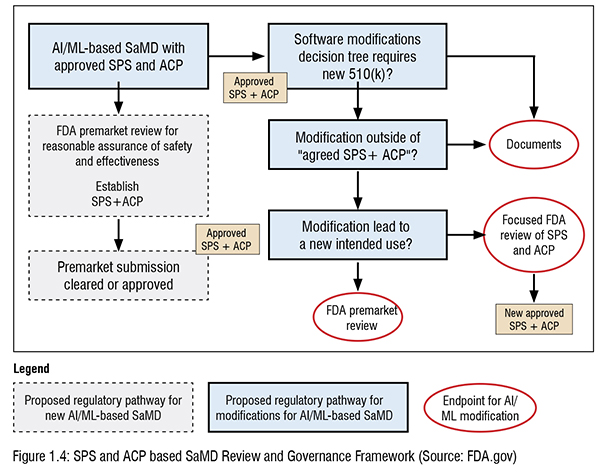
As per Allied Market Research, ‘The global AI in healthcare market was valued at US$ 8.23 billion in 2020, and is projected to reach US$ 194.4 billion by 2030, growing at a CAGR of 38.1 per cent from 2021 to 2030’ as illustrated in Figure 1.3. The Asia Pacific applied AI healthcare market on the other hand was just at an estimate of $274 million of the US$ 8,230 million global market back in 2020, as per Pure Storage. Thus, the Asia-Pacific market was just 3.3 per cent in terms of Market Share in 2020, though it is set to grow at a faster pace of 48 per cent from 2020- 27. Despite the burgeoning interest and growth expected in the market, AI as a technology is still incredibly young. To make matters worse, the industry is ridden with challenges in terms of 1> lack of capture of actionable data, 2> unavailability of machine driven meta data, in a structured database3> lack of regulatory legislation and oversight in terms of security and safety of SaMD and 4>unwanted inherent bias in the data which is used to train SaMD and aid in its maturity.
Finally, the FDA between 2021 and 2022 have published its review and governance framework illustrated in Figure 1.4, for regulating AI/ML enabled SaMD. The complexity that FDA had to consider prior to setting up this framework was multifold starting from ‘defining and classifying an AI/ ML enabled SaMD as a device’ to the implications on ‘patient safety, data security, clinical responsibility, socioethical consideration and potential IP conflicts’ that may arise out of a selflearning and iteratively transforming AI algorithm. The FDA governance framework displayed in Figure 1.4, tackled this incumbent problem by asking SaMD manufacturers to declare and abide by a ‘Predetermined Change Control Plan’ comprising of the belowmentioned two sub-parts:
1>‘SaMD Pre-Specifications (SPS): This will describe "what" aspects the manufacturer intends to change through learning’
2>‘Algorithm Change Protocol (ACP): This will explain "how" the algorithm will learn and change while remaining safe and effective’
Further to the above, the FDA has deliberated at length on potential Intellectual Property (IP) issues that may arise out of multiple self-learning algorithms of standard and robust architecture, converging on similar hyperparameter values as each other, while being potentially exposed to patient data of similar demography or ailment. To mitigate this intrinsic problem that may exist in the current ANI driven SaMD, the FDA urges the manufacturers to submit periodic addendums to their existing IP as the primary protective measure safeguarding interests of the manufacturer.
Though this seems to be a stop-gap solution, is also the best bet that any SaMD manufacturer would have against potential IP infringement which may get realized owing to the modus-operandi of any SaMD.
The above FDA framework depicts a forward-looking iterative solution to a self-learning SaMD and only future will determine how this impacts the potential issues with regards to legislature.
In addition, the FDA has also etched ten guiding principles as best practices to be adopted for medical device development, as shown in Figure 1.5. These principles are aimed at but at the same time limited to bringing forth, safer and secure regulatory control towards SaMD development.
Hence, there is a GAP in terms of relevance and advocacy for the multitude of functions within the healthcare industry and thereby the Market which seeks to benefit through adoption on ANI models.Establishing broad and comprehensive fundamental principles to enable successful ANI adoption, within multi-faceted Healthcare Industry has therefore become a quintessential necessity. The authors seek to empirically derive these fundamental principles, through an experimental literature survey on adoption guidelines highlighted by many industry experts, academicians, researchers and AI developers, as showcased in the next section.

Experimentation - Studying Journal and Web Literature on AI Adoption guidelines, using Natural Language Processing (NLP):
NLP Technique - Latent Dirichlet Analysis also known as LDA has been used for Topic Modelling
Data Used – From Journals in Google Scholar and Open-Source Articles published online on the topic and keyword:“AI Adoption Guidelines in Healthcare Industry”. The list of same are provided in the references section at the end. Total all text from 25 articles were used. All the articles and Journals were between the years 2014 and 2022.
Web Crawling Tool – Data was captured using My80Legs tool (Source: 80legs.com)
Results: Figure 1.6 and Figure 1.7 depicting the key topics. Coherence Score (c_v): 0.4, optimum alpha value was selected as 0.1
Inference From Topic 0 as shown in Figure 1.7, we can infer that AI or in this case ANI technology adoption require ‘discussions’, ‘guidance’, ‘human support’ and ‘Intervention’ at all levels to formalise ‘guidelines’. The ‘design’ of AI system needs to be ‘inclusive’ and ‘Bias’ in ‘data’ needs to be managed through inclusion and diversity in terms of both legislation and data availability as input to the models. The ANI model ‘output’ needs to be ‘explainable’.
From Topic 1 as shown in Figure 1.7, we can infer that ‘development’ AI or ANI systems fuelling the SaMD adoption need ‘interoperability’ and ‘synergy’. AI ‘system’ ‘development’ require ‘study’ and ‘trials’ through ‘labeled’ data. The ‘labelling’ of data will result in the boundary conditions we create to localise and bind patient outcome to curtail any related fatality.
From Topic 2 as shown in Figure 1.7, we infer that ‘SaMD’ ‘software’ ‘model’ should be able to utilise ‘medical’ ‘datum’ and ‘report’ the outcome effectively. ‘SaMD’ based on AI / ML tech is still at its nascent stage and require ‘guidance.’
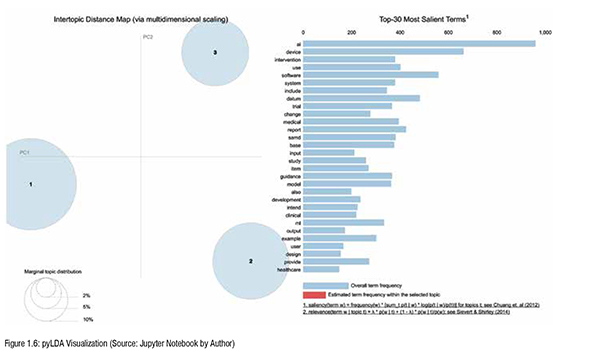

Excerpts from industry discussion with Thingstel CEO on AI adoption guidelines:
1. Check hygiene of the data and source before deployment
2. Diversity and variation of data is a requirement to get desired accuracy with AI
3. Deploy only where necessary and avoid overkill as it may affect the overall feasibility
Excerpts from industry discussion with Velbiom Probiotics CEO on AI adoption guideline
1. Centralised database of Microbiome data
2. Govt/DBT Funding to encourage more Startups to do deep dive
3. Microbiome testing is very expensive currently and if we can price control, it will be better and more patients will go for it. As a result, more data set will be available from all parts of the world.
Summarising the learnings as fundamental principles:
In this article, assessment of AI tech for Healthcare industry usage,has been performed using the following methodology – a) Extensive Research, b) Decades of professional experience, in analytics and AI/ML services, c) SaMD development and deployment experience andc) Discussions with numerous business leaders, attempting to adopt AI practices in their tradecraft.
Through research, surveys, discussions and collective experience in attempting to adopt AI, it is deduced that the following five Fundamental principles, will govern successful adoption of AI, in the near future–
1. AI/ML enabled SaMD systems Interoperability
2. The ‘design’ of AI system needs to be ‘inclusive’ and ‘bias’ in ‘data’ needs to be managed through inclusion and diversity in terms of both legislation and data availability as input to the models.
3. The ANI model ‘output’ needs to be ‘explainable’. AI/ ML enabled SaMD adoption require ‘discussions’, ‘guidance’, ‘human support’ and ‘Intervention’ to formalise ‘guidelines’. ‘SaMD’ based on AI / ‘ML’ tech is still at its nascent stage and require ‘guidance.’
4. SaMD adoption need ‘interoperability’ and ‘synergy’. AI ‘system’ ‘development’ require ‘study’ and ‘trials’ through ‘labeled’ data.
5. The ‘labelling’ of data will result in the boundary conditions we create to localise and bind patient outcome to curtail any related fatality.
Nonetheless, the authors are also mindful of the fact that the industry, developers and users are still witnessing the youth of ANI and corresponding nuances. With time many new learnings will become known. Therefore, as a protective best practice, the authors recommend the age-old law applied in the field of Industrial Robotics (derived from Isaac Asimov's "Three Laws of Robotics”) since decades, as the sixth and final fundamental principle, which states:
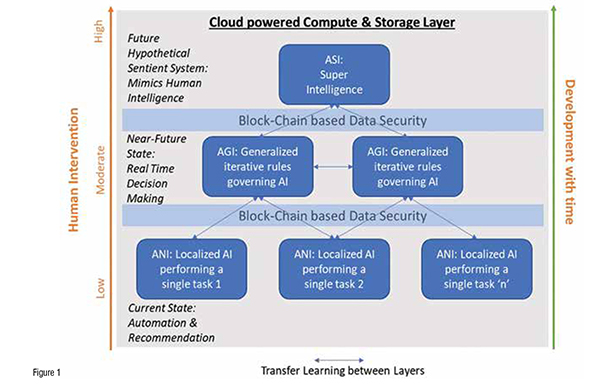
A robot may not injure a human being or, through inaction, allow a human being to come to harm. A robot must obey the orders given it by human beings except where such orders would conflict with the First Law (source: Wikipedia)
These fundamental principles will be relevant for all functions within the industry, starting from healthcare manufacturing to drug designing to clinical diagnostics to hospitals and home-care, enabling doctors and hospitals to drive better, safer and secure patient outcomes.
In conclusion, adoption of ANIin healthcare is becoming inevitable, but the aforementioned 6 fundamental principles, will ensure fewer collective failures and thereby pave the path for a true, successful and easy adoption.
Future
Human beings have always built the basic functioning layer of any device first and built the futuristic views on top of it in layers, in logical integrated steps.
- For example, we built a cart with round wheels and today we build smart and connected cars by building layers of complexity on top of it. However, the basic structure remained the same.
- Development of DL in AI has been no different, starting from the base perceptron architecture biomimicking a single neuronal ganglion to the complex Neural Nets of the world built via addition of numerous layers in the architecture with Hyperparameters of weights and biases.
Based on the same human philosophy and human creative trend, we hypothesise the probable design / architecture which might ease the rise of ASI soon, as illustrated in the Figure 1.8 below –
Acknowledgements
Sindhu Ramesh, Principal Data Scientist at Affine, Saikat Ray, CEO at Velbiom Probiotics, Abhishek Narsipur, CEO at Thingstel, Sujan Deb, Critical Care Unit physician at Fortis Hospital and Nivedita Roy, Analytics Manager, Accenture Consulting.